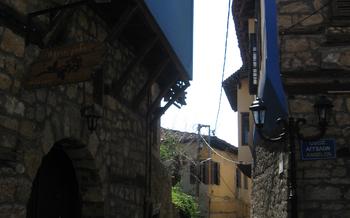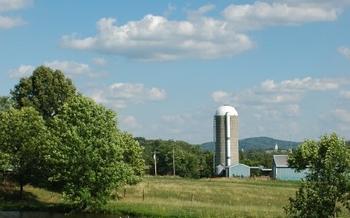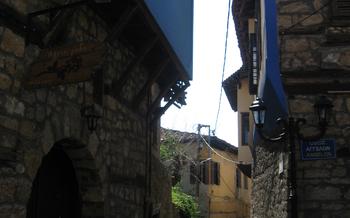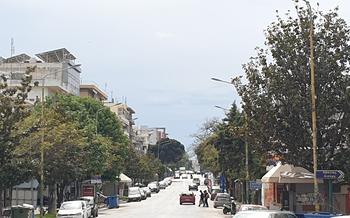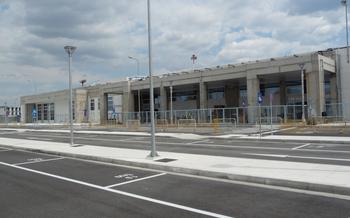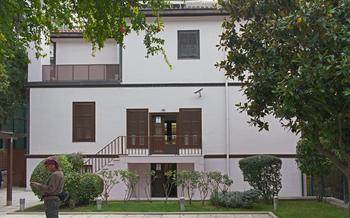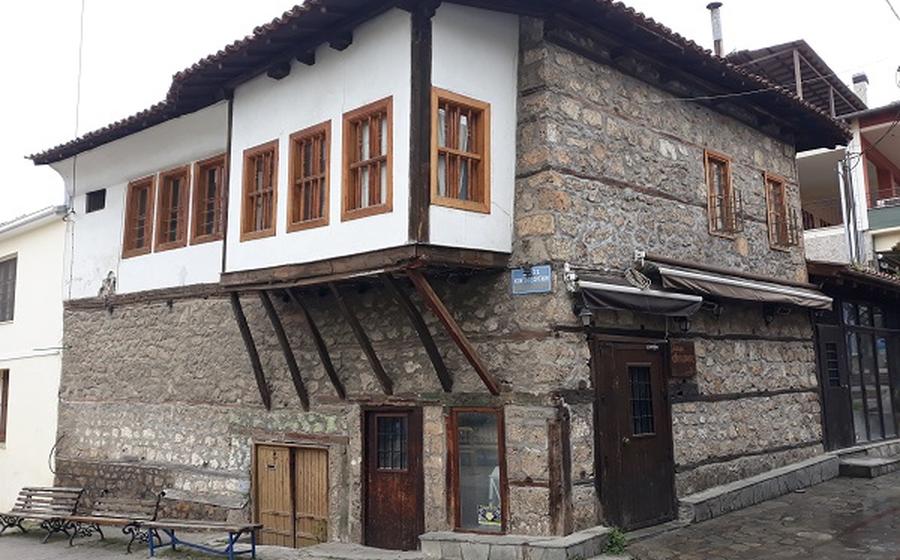
The Cave of the Bear at Nymfaio (nearby attraction)
- The Cave of the Bear at Nymfaio
- Transportation to Nymfaio
- Location and Natural Surroundings
- Nymfaio Village: A Cultural Haven
- Guided Tours
- Self-Guided Exploration
- Cave's Interior
- Paleontological Discoveries
- Archaeological Excavations
- Conservation and Sustainability
- Educational Programs
- Accessibility and Facilities
- Visiting Hours and Ticket Prices
- Nearby Attractions
- Insider Tip
The Cave of the Bear at Nymfaio
The Cave of the Bear, known locally as Arkoudospilios, is a natural wonder located near the picturesque village of Nymfaio in the Veria region of Greece. Steeped in historical significance, the cave has captivated visitors with its unique geological formations, rich archaeological discoveries, and the allure of its paleontological treasures.
Throughout history, the cave has served various purposes, from a sanctuary for prehistoric animals and early human settlements to a place of refuge and worship. Its name derives from the abundance of fossilized bear bones found within its chambers, shedding light on the cave's role as a significant habitat for these now-extinct creatures.
Beyond its paleontological significance, the cave boasts stunning geological formations, including intricate stalactites and stalagmites that adorn its walls and ceilings. These speleothems, formed over thousands of years by the slow dripping of water, create a mesmerizing spectacle of natural artistry. The cave's chambers vary in size and shape, connected by narrow passages and tunnels that add an element of adventure to the exploration.
In addition to its natural wonders, the Cave of the Bear has yielded remarkable archaeological discoveries. Excavations have unearthed artifacts from different periods, including tools, pottery, and jewelry, providing valuable insights into the human presence and activities within the cave. These findings have contributed to our understanding of ancient civilizations and their connection to this unique natural site.
Transportation to Nymfaio
Nymfaio is conveniently accessible from major cities in Greece, with various transportation options available to suit different preferences and budgets. From Thessaloniki, the vibrant capital of Macedonia, you can embark on a scenic 110-kilometer drive that takes approximately 1 hour and 45 minutes. Regular buses also ply this route, offering a comfortable and affordable journey.
If you are coming from Athens, the journey is longer but equally rewarding. The distance between Athens and Nymfaio is around 560 kilometers, and the drive takes about 6 hours. Alternatively, you can opt for a leisurely train ride, which takes approximately 7 hours and 30 minutes. Once in Veria, you can easily catch a connecting bus or taxi to reach Nymfaio.
Whether you choose to drive, take a bus, or travel by train, the journey to Nymfaio is a delightful experience. The picturesque landscapes, dotted with charming villages and rolling hills, offer a glimpse of the region's natural beauty.
If you are planning a day trip to Nymfaio from Thessaloniki or Veria, it is advisable to start early to make the most of your time. For those seeking a more immersive experience, consider spending a few days in the village, allowing ample time to explore the cave, soak up the local culture, and discover the surrounding attractions.
For those arriving by car, Nymfaio offers ample parking facilities, ensuring a hassle-free visit. The village's compact size and pedestrian-friendly streets make it easy to navigate on foot, allowing you to fully appreciate its architectural charm and vibrant atmosphere.
Location and Natural Surroundings
The Cave of the Bear is located in the picturesque village of Nymfaio, in the Veria region of Greece. It lies nestled amidst stunning natural surroundings, with lush forests, rolling hills, and breathtaking vistas. The area surrounding the cave is a haven for nature enthusiasts, offering a diverse range of flora and fauna. Visitors can spot various bird species, including eagles, vultures, and falcons, soaring through the skies. The surrounding forests are home to a variety of wildlife, including foxes, hares, and wild boars. The Cave of the Bear is an integral part of this rich ecosystem, adding to the natural beauty and ecological significance of the region.
Combining a visit to the cave with other natural attractions in the vicinity, such as the nearby waterfalls, hiking trails, and scenic viewpoints, offers a holistic experience that allows visitors to immerse themselves in the natural wonders of the Veria region.
Nymfaio Village: A Cultural Haven
Nestled in the heart of the Veria region, the village of Nymfaio exudes a timeless charm that transports visitors to a bygone era. Its rich history dates back to the 14th century when it was founded by Vlach shepherds seeking refuge from the Ottoman Empire. Over the centuries, Nymfaio flourished as a trading center and a hub for cultural exchange, leaving a legacy of architectural wonders and vibrant traditions.
Strolling through the cobblestone streets of Nymfaio, visitors are greeted by an array of traditional stone houses, each adorned with intricate carvings and colorful facades. Many of these buildings have been lovingly restored and converted into charming hotels, guesthouses, and tavernas, offering travelers a glimpse into the village's rich past.
Nymfaio's culinary scene is a testament to its diverse cultural heritage. Visitors can savor traditional Greek dishes infused with local flavors and ingredients. From hearty stews and grilled meats to homemade pastries and artisanal cheeses, the village's cuisine is a feast for the senses.
For those seeking a truly immersive experience, Nymfaio offers a range of accommodation options that blend modern comforts with rustic charm. From cozy guesthouses nestled amidst cobblestone alleys to luxurious boutique hotels with breathtaking views, there's something to suit every taste and budget.
Guided Tours
Discovering the Cave of the Bear with a guided tour offers a comprehensive and immersive experience. Trained guides provide in-depth insights into the cave's history, geology, and archaeological significance. They lead visitors through the cave's chambers, pointing out key features and formations. Guided tours typically last around 45 minutes to an hour, allowing ample time for exploration and questions.
Booking a guided tour is recommended to make the most of your visit. Tours are available in multiple languages, ensuring accessibility for non-native speakers. Prices vary depending on the group size and the time of the year. Advance booking is advisable, especially during peak tourist season, to secure your spot. Guided tours offer a deeper understanding of the cave's significance and provide a memorable experience for visitors of all ages.
Self-Guided Exploration
The Cave of the Bear offers the opportunity for visitors to embark on a self-guided exploration and discover its wonders at their own pace. Detailed maps and informative signage are provided to guide visitors through the cave's chambers and passages. Safety guidelines are also displayed to ensure a safe and enjoyable experience for all.
Exploring the cave independently allows visitors to immerse themselves in its natural beauty and contemplate the geological formations and archaeological discoveries at their leisure. The duration of a self-guided tour can vary depending on the pace and level of interest, but it generally takes around one hour to explore the cave's main chambers.
Recommended equipment for self-guided exploration includes comfortable shoes, a flashlight or headlamp for navigating dimly lit areas, and a camera to capture the unique features of the cave. It's important to note that the cave's interior can be uneven and slippery in places, so proper footwear is essential.
During self-guided visits, visitors should pay attention to points of interest such as the impressive stalactites and stalagmites, which come in various shapes and sizes. The cave's chambers also showcase unique rock formations, including flowstones, curtains, and columns, each telling a story about the geological processes that have shaped this underground wonderland.
Cave's Interior
The Cave of the Bear at Nymfaio captivates visitors with its stunning geological formations and intricate speleothems. As you venture into the cave, you'll be awestruck by the towering stalactites that descend from the ceiling like frozen waterfalls. Their delicate shapes and diverse colors create a mesmerizing spectacle, especially when illuminated by the ambient lighting.
Look down to discover an equally impressive array of stalagmites rising from the cave floor. These majestic pillars, formed by mineral deposits over thousands of years, exhibit a variety of shapes and sizes, some resembling ancient sculptures. The interaction between stalactites and stalagmites creates breathtaking columns and curtains that add to the cave's otherworldly charm.
The chambers within the cave vary in size and height, offering a diverse range of experiences. From intimate passages that require crouching to expansive halls that echo with the sound of dripping water, each chamber reveals its own unique beauty. The overall layout of the cave is intricate, with winding tunnels, hidden alcoves, and narrow crevices that invite exploration.
Paleontological Discoveries
The Cave of the Bear at Nymfaio has yielded significant paleontological findings, shedding light on the region's rich prehistoric past. Fossil remains of various extinct animals, including bears, have been discovered within the cave's chambers. These fossils provide valuable insights into the evolution of life and the ancient ecosystems that existed in this part of Greece.
The presence of bear fossils is particularly noteworthy, as the cave's name suggests. These remains have been instrumental in studying the behavior and characteristics of extinct bear species. Researchers have analyzed the fossils to gain a better understanding of the bears' diet, habitat preferences, and evolutionary relationships.
The paleontological discoveries made at the Cave of the Bear have contributed to our understanding of the region's biodiversity and the processes that have shaped its current ecosystems. These findings have also helped scientists reconstruct the environmental conditions and climate changes that occurred during different geological periods.
Continuing research and excavations at the cave hold the potential for further paleontological discoveries, offering valuable insights into the history of life and the intricate web of interactions that shaped the natural world in this region.
Archaeological Excavations
Extensive archaeological excavations have been conducted within the depths of the Cave of the Bear at Nymfaio, revealing a rich tapestry of human presence and activities throughout different periods of history. Archaeologists have unearthed a treasure trove of artifacts, including tools crafted from stone and bone, pottery fragments with intricate designs, and delicate pieces of jewelry adorned with precious gemstones. These discoveries provide tangible evidence of the cave's significance as a shelter, a place of worship, and a potential site of prehistoric mining operations.
The artifacts unearthed during the excavations have shed light on the diverse cultures that inhabited the region in ancient times. Some of the pottery fragments bear similarities to those found in neighboring regions, suggesting cultural exchange and trade networks. Others display unique characteristics, hinting at the existence of a distinct local culture that thrived in the area.
The interpretation of the archaeological findings has allowed researchers to piece together a fascinating narrative of the human experience within the cave. It is believed that the cave was first used by nomadic hunter-gatherers seeking shelter and protection from the elements. Over time, it evolved into a more permanent settlement, with evidence of hearths, storage pits, and sleeping areas. The presence of mining tools and slag suggests that the cave may have also served as a site for extracting and processing minerals.
The archaeological excavations at the Cave of the Bear have provided invaluable insights into the lives of our ancestors, offering a glimpse into their daily activities, technological advancements, and cultural practices. These discoveries have contributed significantly to our understanding of the rich tapestry of human history in the Veria region and beyond.
Conservation and Sustainability
The Cave of the Bear at Nymfaio is a fragile and irreplaceable natural and cultural heritage site. Conservation efforts are paramount to protect its unique geological formations, archaeological treasures, and diverse ecosystem. Sustainable tourism practices are implemented to minimize human impact and ensure the preservation of the cave for future generations.
Visitors are encouraged to adhere to the established guidelines and regulations to protect the cave's environment. These include staying on designated paths, avoiding touching or damaging rock formations, and refraining from littering. Flash photography is not permitted to prevent harm to the cave's delicate ecosystem.
The cave's management team actively monitors and maintains the site, ensuring that necessary conservation measures are in place. Regular cleaning and maintenance activities are conducted to address any potential threats to the cave's integrity. Sustainable practices, such as energy-efficient lighting and waste management systems, are also implemented to reduce the environmental footprint.
By embracing responsible tourism and following the established guidelines, visitors can contribute to the preservation of The Cave of the Bear at Nymfaio, ensuring that its wonders continue to captivate and inspire generations to come.
Educational Programs
The Cave of the Bear at Nymfaio offers a range of educational programs and activities that cater to students, families, and lifelong learners. These programs are designed to enhance visitors' understanding of the cave's natural, historical, and cultural significance.
Educational tours led by experienced guides provide insights into the cave's geology, paleontology, and archaeology. Interactive workshops and lectures delve deeper into specific topics, such as cave formation processes, fossil identification, and ancient human behavior.
School groups can benefit from customized programs that align with their curriculum and educational goals. Field trips to the cave offer hands-on learning opportunities that complement classroom lessons and foster a sense of wonder and curiosity about the natural world.
The cave's educational programs are not limited to school groups. Adult learners and families can participate in educational events, workshops, and guided tours tailored to their interests and knowledge level. These programs provide a unique opportunity to learn about the cave's rich history and its role in shaping the region's natural and cultural heritage.
In collaboration with educational institutions and research organizations, the cave also hosts seminars, conferences, and workshops that bring together experts in various fields to share their knowledge and insights about the cave's significance. These events foster interdisciplinary collaboration and contribute to the advancement of scientific research and understanding of the cave and its surroundings.
Accessibility and Facilities
Ensuring a welcoming and inclusive environment, the Cave of the Bear at Nymfaio provides accessibility features to cater to visitors with disabilities. Wheelchair ramps and designated parking spaces facilitate easy access to the cave entrance. Inside, well-lit pathways, handrails, and strategically placed seating areas allow for comfortable exploration.
For added convenience, restrooms, drinking water fountains, and designated seating areas are available throughout the cave complex. The visitor center, located near the entrance, serves as a comprehensive information hub, where multilingual assistance is offered to international visitors. Knowledgeable staff is on hand to provide guidance, answer questions, and recommend customized itineraries based on individual interests and abilities.
In line with sustainable tourism practices, the cave has implemented measures to reduce its environmental impact and preserve its natural beauty. Recycling bins are placed throughout the site, encouraging visitors to contribute to waste reduction efforts. The use of eco-friendly materials and energy-efficient lighting systems further demonstrates the cave's commitment to responsible tourism.
Visiting Hours and Ticket Prices
The Cave of the Bear at Nymfaio welcomes visitors during specific hours and days of the week. To plan your visit effectively, it's important to be aware of the operating schedule:
- Operating Hours:
- The cave is generally open to the public from Tuesday to Sunday.
-
Operating hours typically fall between 9:00 AM and 5:00 PM.
-
Ticket Prices:
- Standard admission tickets are available for adults, children, and groups.
- Adult tickets may range from 5 to 10 euros, while children's tickets are often discounted.
-
Group discounts may be offered for larger parties or educational groups.
-
Discounts and Concessions:
- Reduced ticket prices may be available for students, seniors, or individuals with disabilities.
-
It's advisable to inquire about potential discounts when purchasing tickets.
-
Advance Booking:
- While advance booking is not mandatory, it's recommended during peak tourist seasons or for larger groups.
- Booking in advance can help secure your spot and avoid waiting times.
Before your visit, check the official website or contact the visitor center for the most up-to-date information on visiting hours, ticket prices, and any special offers or events.
Nearby Attractions
The Cave of the Bear at Nymfaio is just one of the many captivating attractions that the Veria region has to offer. While visiting the cave, travelers should take the opportunity to explore the surrounding area and discover its rich history, natural beauty, and cultural heritage.
Just a short drive from the cave, visitors can explore the historic city of Veria, with its well-preserved Byzantine churches, Ottoman mosques, and the ancient ruins of the Roman city of Beroea. The city is also known for its vibrant culinary scene, offering a range of traditional Greek dishes and local delicacies.
Nature enthusiasts will find plenty to explore in the vicinity of the cave. The Veria region is home to several picturesque villages, nestled amidst stunning mountain landscapes. Hiking trails wind through lush forests, offering breathtaking views and encounters with local flora and fauna. The region is also home to several natural wonders, including waterfalls, gorges, and thermal springs.
For those seeking a spiritual experience, there are numerous monasteries and churches scattered throughout the region. These sacred sites offer a glimpse into the rich religious history of Greece and provide a tranquil retreat from the hustle and bustle of daily life.
By combining a visit to the Cave of the Bear with explorations of the surrounding area, travelers can create a memorable and enriching itinerary that encompasses history, nature, and culture. Whether it's exploring ancient ruins, savoring local delicacies, hiking through scenic landscapes, or seeking spiritual enlightenment, the Veria region offers something for every traveler.
Insider Tip
For an unforgettable experience, plan your visit to the Cave of the Bear during the early morning or late afternoon hours. The natural light filtering into the cave creates a magical ambiance, illuminating the rock formations and casting dramatic shadows. You'll have the added advantage of avoiding the larger crowds that typically visit during peak hours.
When exploring the cave, remember to respect the local customs and traditions. Be mindful of the cave's fragile ecosystem and avoid touching or disturbing the rock formations. Take your time to soak in the beauty of this natural wonder and capture its essence through photographs.
As a memento of your visit, consider purchasing a unique souvenir or local product from the nearby shops. You'll find a variety of handmade crafts, pottery, and traditional Greek delicacies that make for excellent gifts or keepsakes. These items not only support the local economy but also serve as a tangible reminder of your adventure in the Cave of the Bear.


